Sunset of the nuclear triad. Cold War missile defense and Star Wars
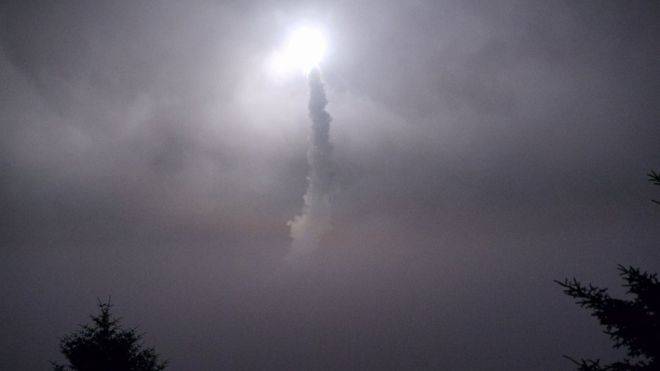
Missile defense appeared as a response to the creation of a powerful weapons в stories human civilization - ballistic missiles with nuclear warheads. The best minds of the planet were involved in creating protection against this threat, the latest scientific developments were researched and put into practice, objects and structures comparable to the Egyptian pyramids were built.
Missile defense of the USSR and the Russian Federation
For the first time, the missile defense problem began to be considered in the USSR in 1945 as part of counteracting the German Fau-2 short-range ballistic missiles (the Anti-Fau project). The project was carried out by the Scientific Research Bureau of Special Equipment (NIBS), headed by Georgy Mironovich Mozharovsky, organized by the Zhukovsky Air Force Academy. The large dimensions of the V-2 missile, the short firing range (about 300 kilometers), as well as the low flight speed of less than 1,5 kilometers per second, made it possible to consider anti-aircraft missile systems (SAM) being developed at that time designed for air defense (air defense).
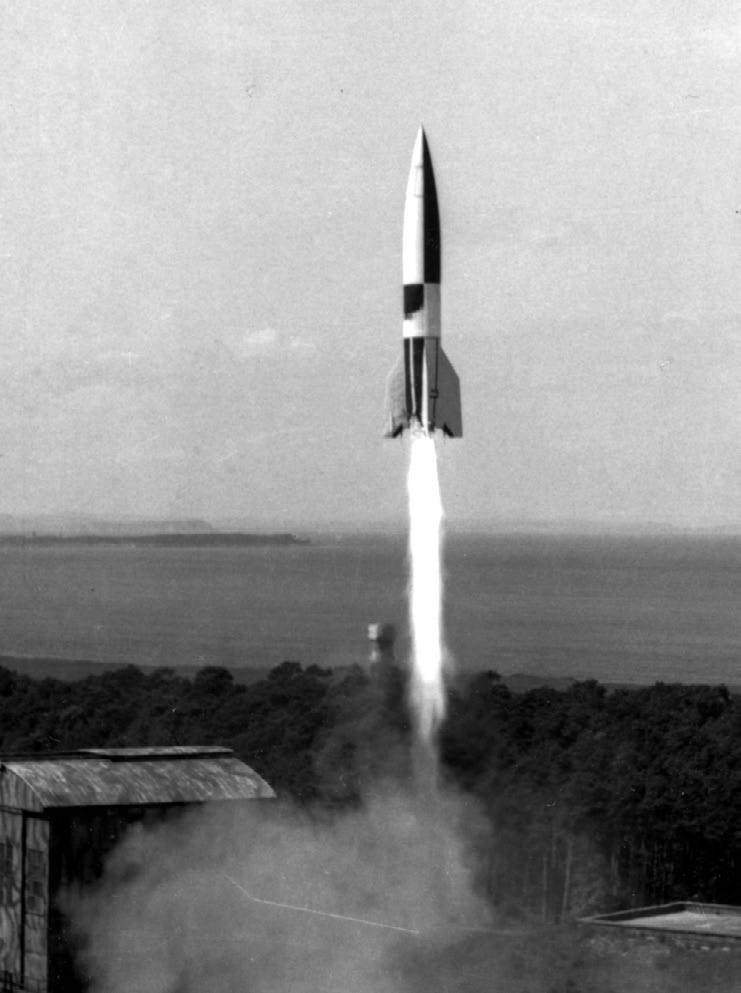
The V-2 launching ballistic missile is a harbinger of a missile threat
The advent of ballistic missiles with a flight range of more than three thousand kilometers and a detachable warhead by the end of the 50s made it impossible to use “conventional” air defense systems against them, which required the development of fundamentally new missile defense systems.
In 1949, G.M. Mozharovsky introduced the concept of a missile defense system capable of protecting a limited area from the impact of 20 ballistic missiles. The proposed missile defense system was supposed to include 17 radar stations (radars) with a range of up to 1000 km, 16 near-field radars and 40 precision bearing stations. The capture of the target for escort was to be carried out from a distance of about 700 km. A feature of the project that made it unrealizable at that time was an interceptor missile, which should be equipped with an active homing radar (ARLGSN). It is worth noting that missiles with ARLGSNs became widespread in the SAM near the end of the 350th century, and even now their creation is not an easy task, which is confirmed by the problems in creating the latest Russian S-40 Vityaz air defense system. On an element base of the 50s - XNUMXs, it was unrealistic to create missiles with ARLGSN in principle.
Despite the fact that it was impossible to create a really functioning missile defense system based on the concept presented by G.M. Mozharovsky, it showed the fundamental possibility of its creation.
In 1956, two new missile defense system projects were submitted for consideration: the Barrier zonal missile defense system, developed by Alexander Lvovich Mints, and the three-range missile defense system, System A, proposed by Grigory Kisunko. The missile defense system "Barrier" assumed the sequential installation of three meter-long radars oriented vertically upwards with an interval of 100 km. The trajectory of a rocket or warhead was calculated after the successive intersection of three radars with an error of 6-8 kilometers.
G.V. Kisunko’s project used the Danube-type decimetric station, the most recent at that time, developed at NII-108 (NIIDAR), which made it possible to determine the coordinates of an attacking ballistic missile with meter accuracy. The disadvantage was the complexity and high cost of the Danube radar, but taking into account the importance of the problem being solved, the issues of economy were not priority. The ability to aim with meter accuracy allowed to hit the target not only with a nuclear, but also with a conventional charge.
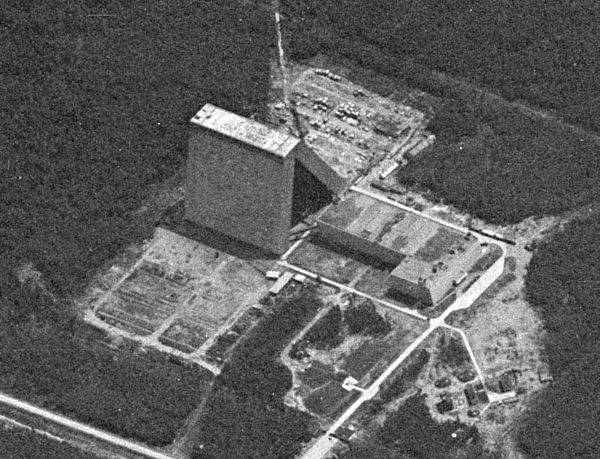
Radar "Danube"
In parallel, OKB-2 (Design Bureau "Fakel") was developing a missile, which received the designation B-1000. The two-stage missile included the first solid-fuel stage and the second stage, equipped with a liquid-propellant engine (LRE). The range of controlled flight was 60 kilometers, the interception height was 23-28 kilometers, with an average flight speed of 1000 meters per second (maximum speed of 1500 m / s). The rocket weighing 8,8 tons and a length of 14,5 meters was equipped with a conventional warhead weighing 500 kilograms, including 16 thousand steel balls with a tungsten carbide core. The defeat of the target occurred over a period of less than one minute.
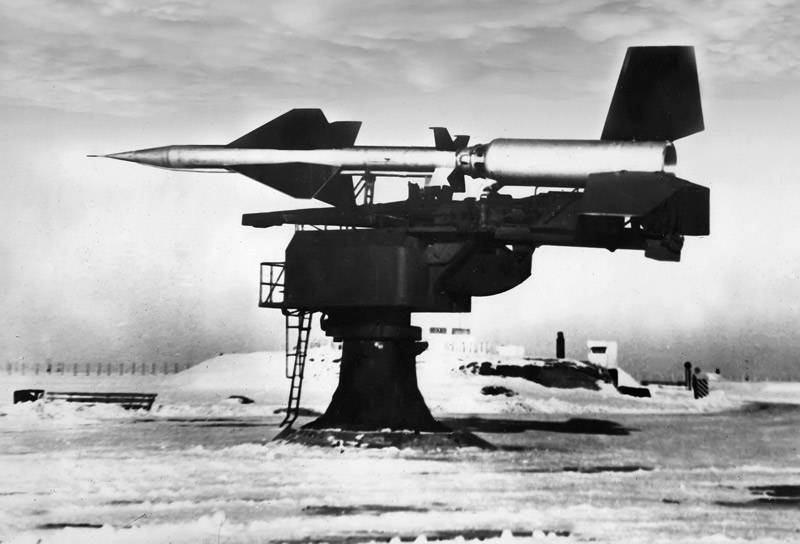
Missile defense V-1000
Experienced missile defense "System A" was created at the Sary-Shagan training ground since 1956. By mid-1958, construction and installation work was completed, and by the fall of 1959, work on connecting all systems was completed.
After a series of unsuccessful trials, on March 4, 1961, the R-12 ballistic missile warhead was intercepted with a weight equivalent of a nuclear charge. The warhead collapsed and partially burned in flight, which confirmed the possibility of successful destruction of ballistic missiles.
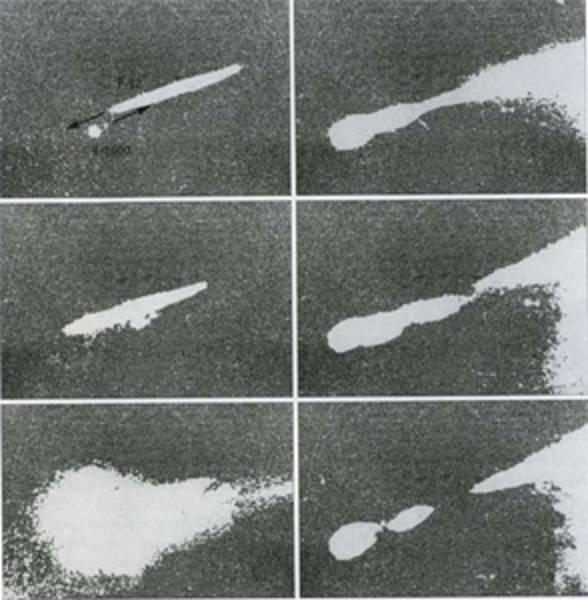
R-12 missile warhead intercept frames V-1000 missile defense
The accumulated backlog was used to create the A-35 missile defense system, designed to protect the Moscow industrial area. The development of the A-35 missile defense system began in 1958, and in 1971 the A-35 missile defense system was adopted (the final commissioning took place in 1974).
The A-35 missile defense system included a decimeter-wave Danube-3 radar with 3 megawatt phased array antennas capable of tracking 3000 ballistic targets at ranges up to 2500 kilometers. Target tracking and missile guidance were provided respectively by the RCC-35 tracking radar and the RCT-35 guidance radar. The number of simultaneously fired targets was limited by the number of RCC-35 radars and RKI-35 radars, since they could only work on one target.
The heavy two-stage anti-missile A-350Zh ensured the destruction of the enemy missile warheads at a range of 130-400 kilometers and an altitude of 50-400 kilometers with a nuclear warhead with a capacity of up to three megatons.
The A-35 missile defense system was modernized several times, and in 1989 it was replaced by the A-135 system, including the 5N20 Don-2N radar of the 51T6 Azov long-range interception missile and the 53T6 short-range interceptor missile.
The 51T6 long-range interceptor missile ensured the destruction of targets at a range of 130-350 kilometers and an altitude of about 60-70 kilometers with a nuclear warhead of up to three megatons or a nuclear warhead of up to 20 kilotons. The 53T6 short-range interceptor missile provided for the destruction of targets at a range of 20-100 kilometers and an altitude of about 5-45 kilometers with a warhead of up to 10 kilotons. The modification 53T6M maximum height of the lesion was increased to 100 km. Presumably, 51T6 and 53T6 (53T6M) missile defense systems could use neutron warheads. At the moment, 51T6 missiles are withdrawn from service. On duty there are modernized 53T6M short-range interceptor missiles with extended service life.
Based on the A-135 ABM system, Almaz-Antey Concern is creating a modernized A-235 Nudol ABM system. In March 2018, the sixth tests of the A-235 rocket were conducted in Plesetsk, for the first time with a full-time mobile launcher. It is assumed that the A-235 missile defense system will be able to destroy both ballistic missile warheads and objects in near space with nuclear and conventional warheads. In this regard, the question arises of how the missile guidance will be carried out in the final section: optical or radar guidance (or combined)? And how will the target be intercepted: direct hit (hit-to-kill) or directional fragmentation field?
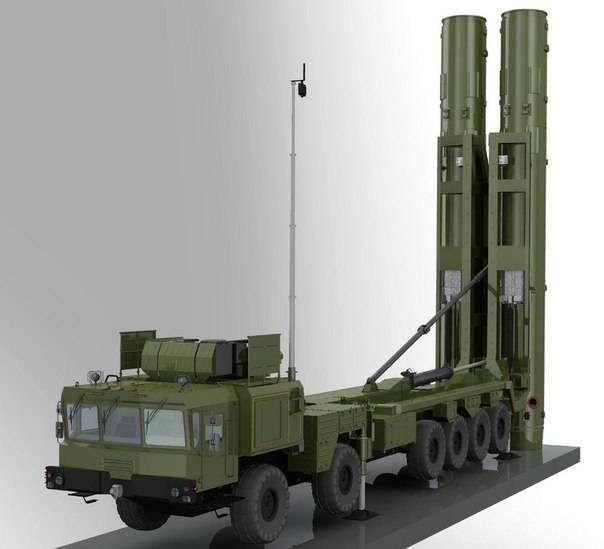
Presumably SPU P222 of complex 14TS033 Nudol on the MZKT-79291 chassis
US missile defense
In the United States, the development of missile defense systems began even earlier - in 1940. The first anti-missile projects, the long-range MX-794 Wizard and the short-range MX-795 Thumper, were not developed due to the lack of specific threats and technology imperfections at that time.
In the 1950s, an intercontinental ballistic missile (ICBM) R-7 appeared on the armament of the USSR, which spurred work in the United States on the creation of missile defense systems.
In 1958, the U.S. Army adopted the MIM-14 Nike-Hercules anti-aircraft missile system, which has limited ability to destroy ballistic targets provided that a nuclear warhead is used. The Nike-Hercules SAM missile ensured the destruction of enemy missile warheads at a range of 140 kilometers and an altitude of about 45 kilometers with a nuclear warhead with a capacity of up to 40 kilotons.
The development of the MIM-14 Nike-Hercules SAM system was the LIM-1960A Nike Zeus complex developed in the 49s with an advanced missile with a range of up to 320 kilometers and a target hit height of up to 160 kilometers. The destruction of ICBM warheads was to be carried out with a 400-kiloton thermonuclear charge with an increased yield of neutron radiation.
In July 1962, the first technically successful interception of an intercontinental ballistic missile by the Nike Zeus missile defense system took place. Subsequently, 10 out of 14 tests of the Nike Zeus missile defense system were recognized as successful.
One of the reasons that prevented the deployment of the Nike Zeus missile defense system was the cost of missile defense, which exceeded the cost of ICBMs of that time, which made the deployment of the system unprofitable. Also, mechanical scanning by rotating the antenna provided an extremely low response time of the system and an insufficient number of guidance channels.
In 1967, at the initiative of US Secretary of Defense Robert McNamara, the development of the Sentinell (Sentinel) missile defense was initiated, later renamed Safeguard (Precaution). The main objective of the Safeguard missile defense system was to protect the positional areas of American ICBMs from a sudden strike by the USSR.
The Safeguard missile defense system created on the new element base should have been significantly cheaper than the LIM-49A Nike Zeus, although it was created on its basis, more precisely, on the basis of an improved version of Nike-X. It included two missile defense systems: the heavy LIM-49A Spartan with a range of up to 740 km, capable of intercepting warheads in near space, and the light Sprint. The LIM-49A Spartan missile with a 71 megaton W5 warhead could hit an unprotected ICBM warhead up to 46 kilometers from the explosion epicenter, protected up to 6,4 kilometers.
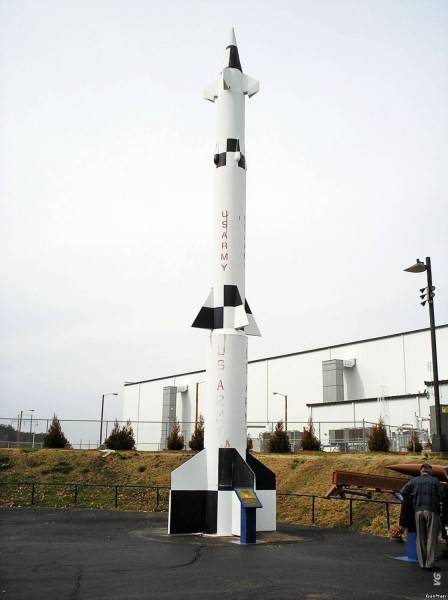
Missile defense LIM-49A Spartan
A Sprint missile with a range of 40 kilometers and a target strike height of up to 30 kilometers was equipped with a W66 neutron warhead with a capacity of 1-2 kilotons.
Preliminary detection and target designation was carried out by a Perimeter Acquisition Radar radar with a passive phased antenna array capable of detecting an object with a diameter of 3200 centimeters at a range of up to 24 km.
Missile Site Radar radar guided missiles were guided and guided by missiles.
Initially, it was planned to protect three airbases with 150 ICBMs on each; in total, 450 ICBMs were thus protected. However, due to the signing of the Treaty on the Limitation of Anti-Ballistic Missile Defense between the USA and the USSR in 1972, it was decided to limit the deployment of the Safeguard missile defense only at the Stanley Mickelsen base in North Dakota.
In total, 30 Spartan and 16 Sprint anti-ballistic missiles were deployed at positions at Safeguard missile defense positions in North Dakota. The Safeguard missile defense system was put into operation in 1975, but already in 1976 it was mothballed. The shift of emphasis of the American Strategic Nuclear Forces (SNF) in favor of the submarine missile carriers made the task of ensuring the protection of ground ICBMs from the first strike of the USSR irrelevant.
"Star Wars"
On March 23, 1983, the fortieth president of the United States, Ronald Reagan, announced the launch of a long-term program of research and development to create a groundwork for the development of a global missile defense system (ABM) with space-based elements. The program was designated the Strategic Defense Initiative (SDI) and the unofficial name for the Star Wars program.
The purpose of the SDI was to create a layered missile defense of the North American continent against massive nuclear weapons strikes. The defeat of ICBMs and warheads was to be carried out on almost the entire flight path. Dozens of companies were involved in solving this problem, billions of dollars were invested. Briefly consider the main weapons developed by the SDI program.
Laser weapons
At the first stage, the take-off Soviet ICBMs were to meet chemical lasers placed in orbit. The operation of a chemical laser is based on the reaction of certain chemical components, an example is YAL-1 iodine-oxygen laser, which was used to implement an aviation version of missile defense based on a Boeing aircraft. The main disadvantage of a chemical laser is the need to replenish the reserves of toxic components, which in relation to a spacecraft actually means a one-time use. However, within the framework of the objectives of the SDI program, this is not a critical drawback, since most likely the entire system will be disposable.
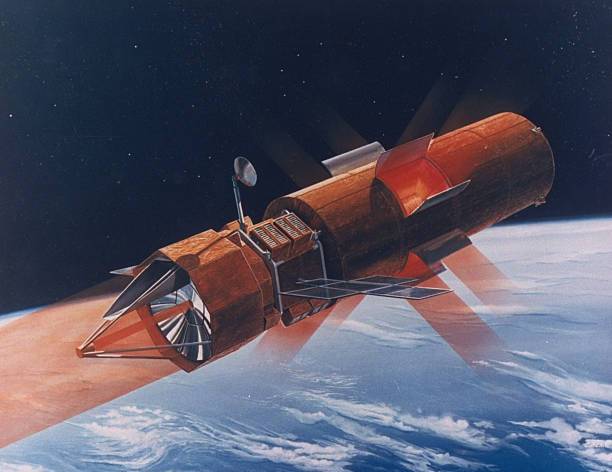
The advantage of a chemical laser is the possibility of obtaining a high working radiation power at a relatively high efficiency. In the framework of Soviet and American projects on chemical and gas-dynamic (a special case of chemical) lasers, it was possible to obtain a radiation power of the order of several megawatts. As part of the SOI program in space, it was planned to deploy chemical lasers with a power of 5-20 megawatts. Orbital chemical lasers were supposed to defeat the starting ICBMs before the separation of warheads.
Perhaps it is a chemical or gas-dynamic laser that can be installed in the Russian Peresvet laser complex. This is with a pessimistic assessment of its design and capabilities.
The USA built an experimental MIRACL laser based on deuterium fluoride, capable of developing a power of 2,2 megawatts. During tests conducted in 1985, the MIRACL laser was able to destroy a liquid ballistic missile fixed at 1 kilometer.
Despite the absence of serial spacecraft with chemical lasers on board, the work on their creation provided invaluable information on the physics of laser processes, the construction of complex optical systems, and heat removal. Based on this information, in the near future it is possible to create a laser weapon that can significantly change the appearance of the battlefield.
An even more ambitious project was the creation of nuclear-pumped X-ray lasers. A package of rods made of special materials is used as a source of hard X-ray radiation in a nuclear-pumped laser. A nuclear charge is used as a pump source. After the nuclear charge is detonated, but until the rods evaporate, a powerful laser pulse is formed in them in the hard X-ray range. It is believed that for the destruction of ICBMs, it is necessary to pump a nuclear charge with a capacity of about two hundred kilotons, with a laser efficiency of about 10%.
The rods can be oriented in parallel to hit a single target with high probability or distributed over several targets, which will require several guidance systems. The advantage of nuclear-pumped lasers is that the hard X-rays generated by them have high penetrating power and it is much more difficult to protect a rocket or warhead from it.
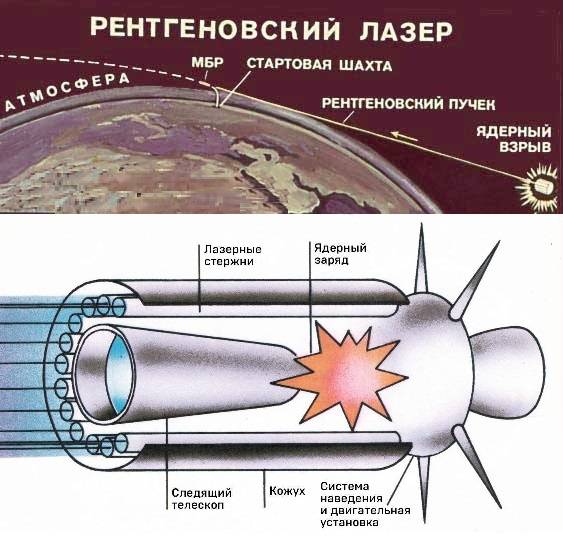
Since the Outer Space Treaty prohibits the deployment of nuclear charges in outer space, they must be put into orbit immediately at the time of the enemy’s attack. To do this, it was planned to use 41 SSBNs (nuclear submarine with ballistic missiles), which previously housed the Polaris ballistic missiles removed from service. Nevertheless, the high complexity of the development of the project led to its transfer to the category of research. It can be assumed that the work has come to a standstill largely due to the impossibility of conducting practical experiments in space for the above reasons.
In 2012, information appeared that in the Russian RFNC-VNIITF a gas laser pumped by a nuclear reactor operating at an atomic xenon transition with a wavelength of 2,03 μm was created. This is another type of nuclear-pumped laser - it uses reactor core pumping. The output energy of the laser pulse was 500 J at a peak power of 1,3 MW. In an optimistic scenario, the Peresvet complex can be equipped with a laser pumped from the reactor core, which can make it a truly dangerous and promising weapon.
Beam weapons
Particle accelerators, the so-called beam weapons, could be even more impressive weapons. Accelerated neutron sources located on automatic space stations were supposed to hit warheads at a distance of tens of thousands of kilometers. The main damaging factor was to be the failure of the electronics of the warheads due to the deceleration of neutrons in the material of the warhead with the release of powerful ionizing radiation. It was also assumed that the analysis of the signature of the secondary radiation arising from neutrons entering the target would make it possible to distinguish real targets from false ones.
The creation of beam weapons was considered an extremely difficult task, and therefore the deployment of this type of weapon was planned after 2025.
Rail weapon
The rail guns, dubbed the “railguns” (steel railguns), were another element of SDI under consideration. In railgun, the dispersal of shells is carried out using the Lorentz force. It can be assumed that the main reason that did not allow the creation of railguns in the framework of the SDI program was the lack of energy storage devices capable of ensuring the accumulation, long-term storage, and fast energy output of several megawatts. For space systems, the problem of guide rail wear, which is inherent in "ground" railguns due to the limited time of the missile defense system, would be less critical.
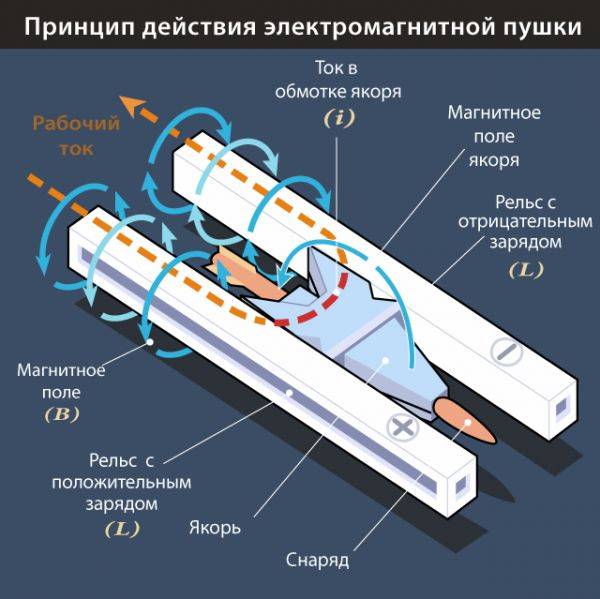
The defeat of the targets was planned to be carried out by a high-speed projectile with a kinetic defeat of the target (without undermining the warhead). At the moment, the United States is actively developing a combat railgun in the interests of the naval forces (Navy), so studies carried out under the SDI program are unlikely to be wasted.
Atomic Buckshot
This is an auxiliary solution designed for the selection of heavy and light warheads. The detonation of an atomic charge with a tungsten plate of a certain configuration was supposed to form a cloud of fragments moving in a given direction at a speed of up to 100 kilometers per second. It was assumed that their energy would not be enough to defeat warheads, but enough to change the trajectory of light false targets.
The obstacle to the creation of atomic buckshot, most likely, was the impossibility of their early placement in orbit and testing due to the US Space Treaty.
"Diamond Pebbles"
One of the most realistic projects is the creation of miniature satellite interceptors, which were supposed to be put into orbit in the amount of several thousand units. It was assumed that they will become the main component of the SDI. The defeat of the target was to be carried out in a kinetic way - by hitting the kamikaze satellite itself, dispersed to 15 kilometers per second. The guidance system was supposed to be performed on the basis of a lidar - a laser radar. The advantage of “diamond pebbles” was that it was built on existing technologies. In addition, a distributed network of several thousand satellites is extremely difficult to destroy with a preemptive strike.
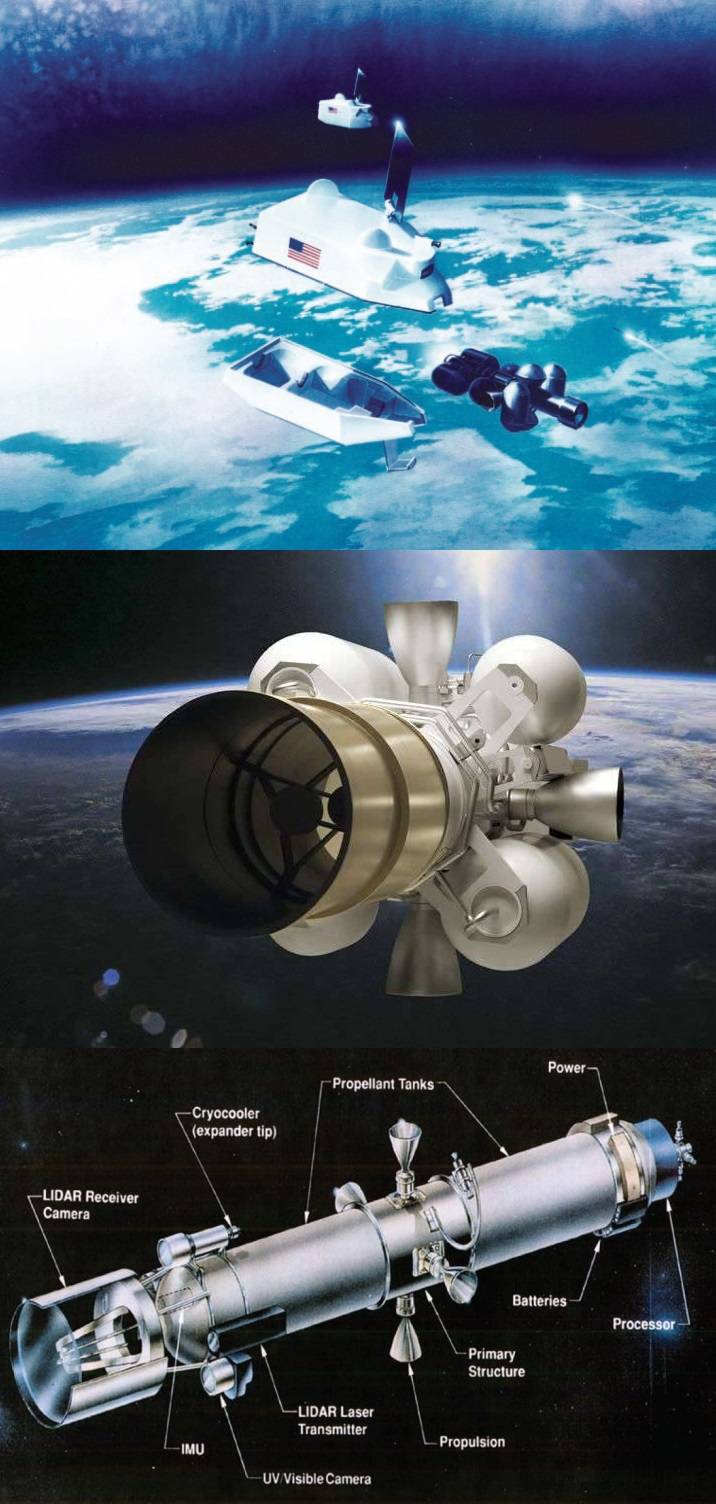
The development of "diamond pebbles" was discontinued in 1994. The developments on this project formed the basis of the kinetic interceptors currently used.
Conclusions
The SDI program is still causing a lot of controversy. Some blame her for the collapse of the USSR, they say, the leadership of the Soviet Union got involved in an arms race that the country could not pull, others talk about the most grandiose "cut" of all time. Sometimes it is surprising that people who proudly recall, for example, the domestic Spiral project (talking about a ruined promising project), are immediately ready to write any unrealized US project into a cut.
The SDI program did not change the balance of forces and did not lead to any massive deployment of serial weapons, nevertheless, thanks to it, a huge scientific and technical reserve was created, with the help of which the latest types of weapons have already been created or will be created in the future. The program’s failures were caused by both technical reasons (the projects were too ambitious) and political ones — the collapse of the USSR.
It should be noted that the existing missile defense systems of that time and a significant part of the development of the SDI program provided for the implementation of many nuclear explosions in the atmosphere of the planet and in near space: missile defense warheads, pumping x-ray lasers, volleys of atomic canister. With high probability, this would cause electromagnetic interference that would render most of the remaining missile defense systems and many other civilian and military systems inoperative. This factor, most likely, became the main reason for the refusal to deploy global missile defense systems at that time. At the moment, technological improvements have made it possible to find ways to solve missile defense problems without the use of nuclear charges, which predetermined a return to this topic.
In the next article, we will consider the current state of US missile defense systems, promising technologies and possible directions for the development of missile defense systems, the role of missile defense in the doctrine of a sudden disarming strike.
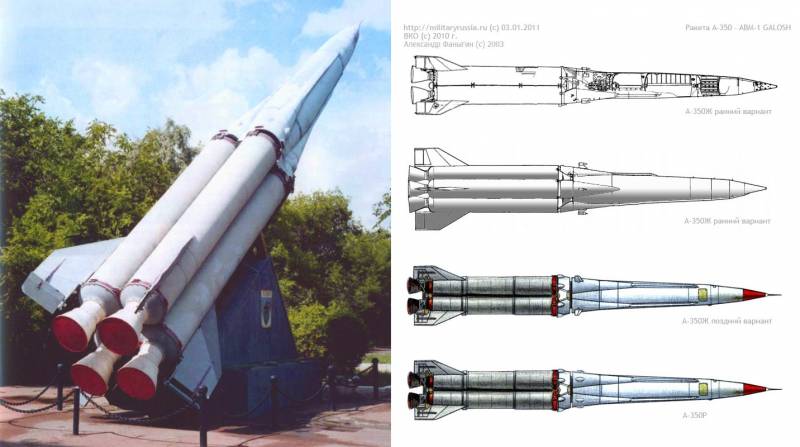
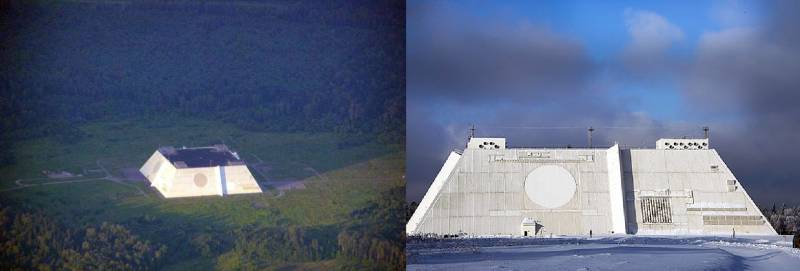
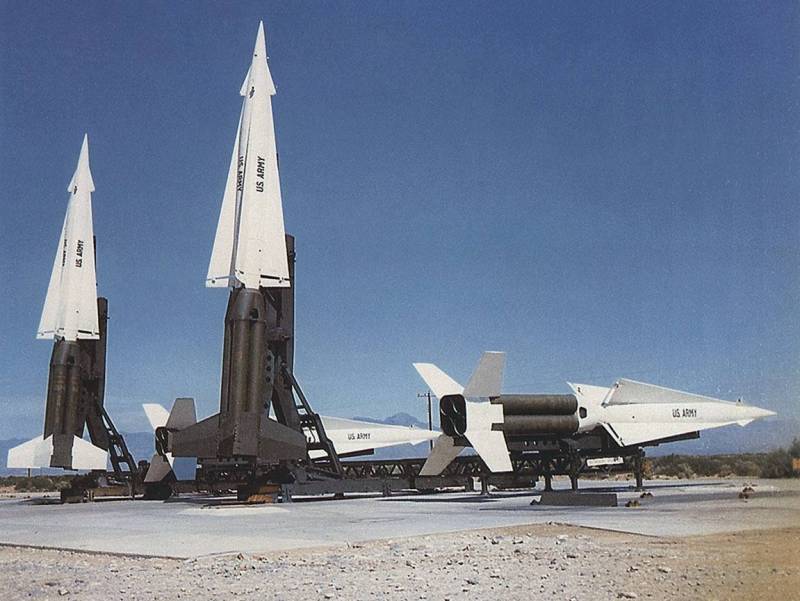
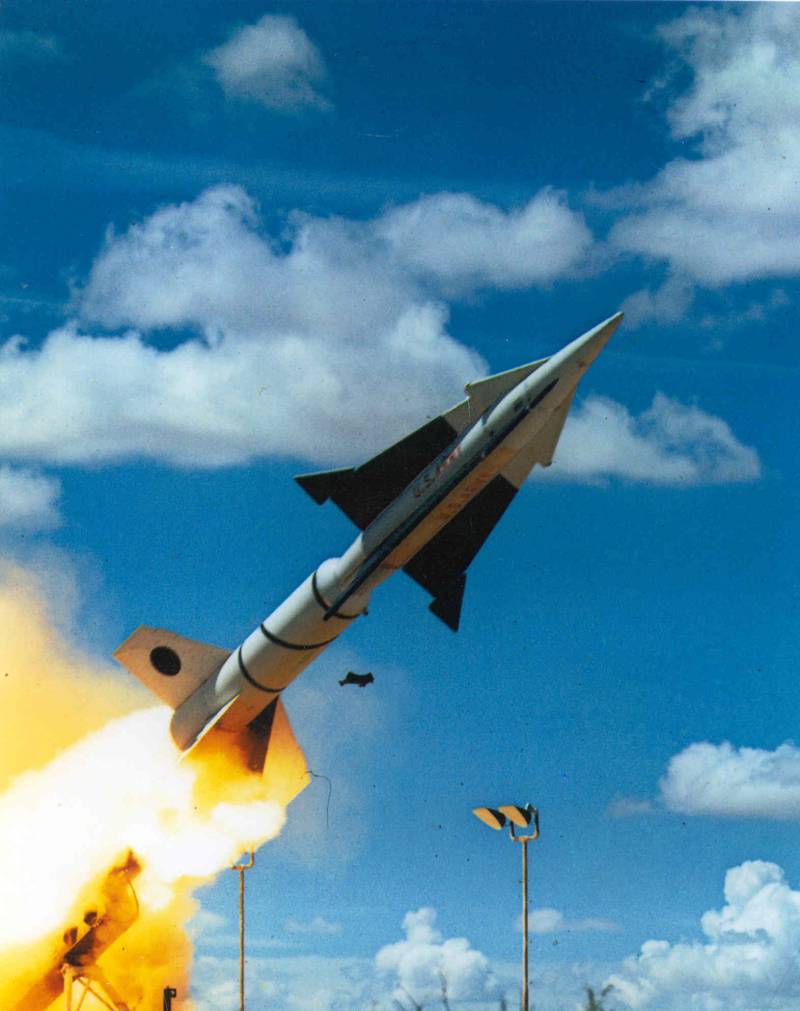
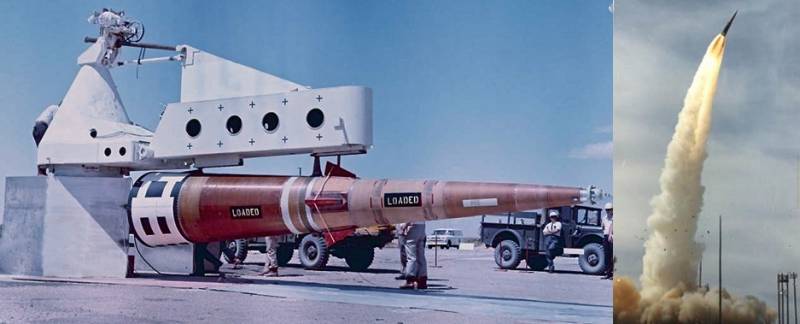
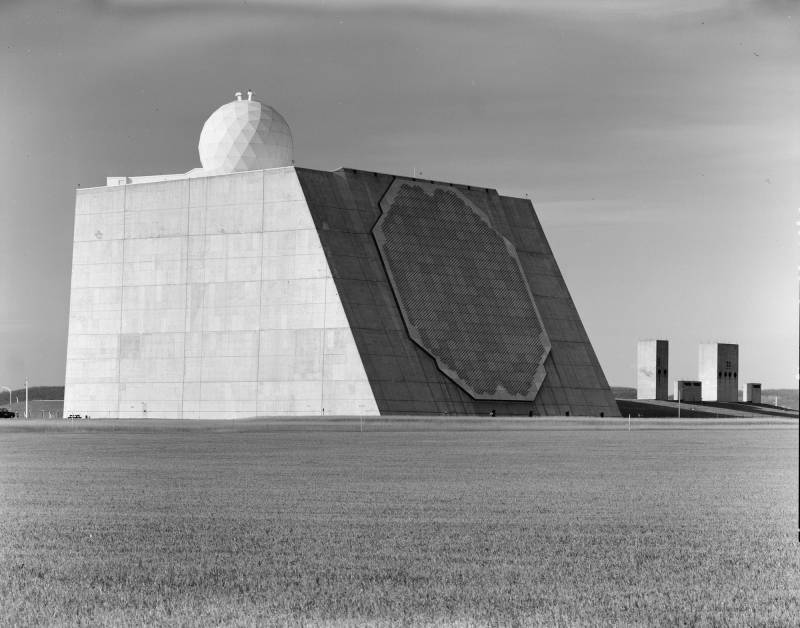
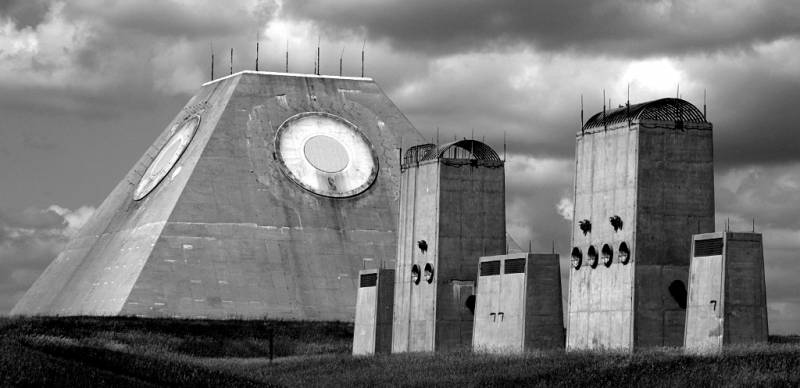
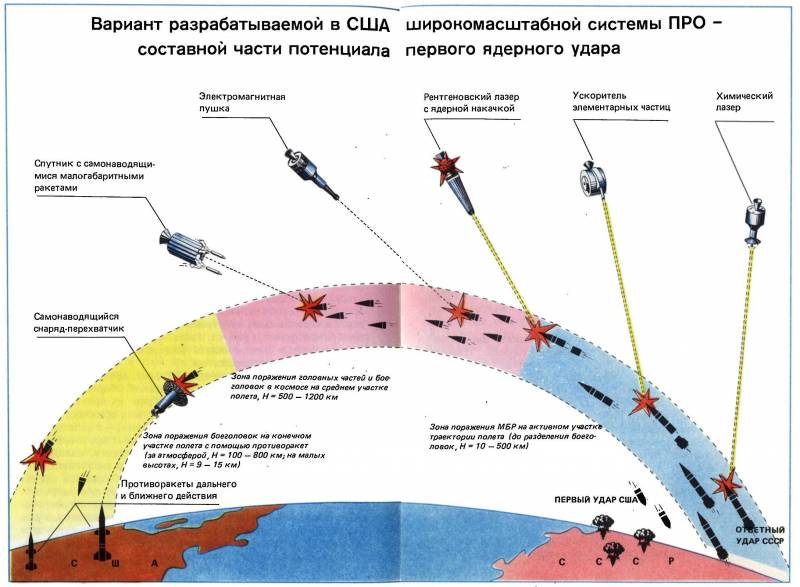
Information